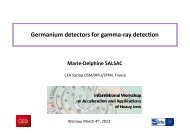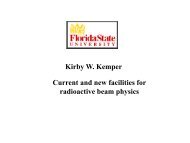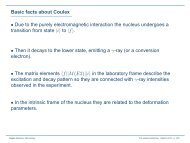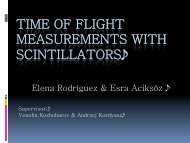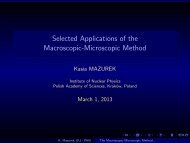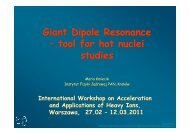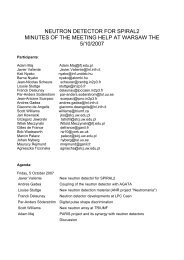nuclear physics in poland 1996 â 2006
nuclear physics in poland 1996 â 2006
nuclear physics in poland 1996 â 2006
- No tags were found...
Create successful ePaper yourself
Turn your PDF publications into a flip-book with our unique Google optimized e-Paper software.
NUCLEAR PHYSICS IN POLAND – APPLICATIONS ANDINTERDISCIPLINARY RESEARCHPawel OlkoH. Niewodniczański Institute of Nuclear Physics PAN, KrakówThe general public frequently associates<strong>nuclear</strong> <strong>physics</strong> with the development of <strong>nuclear</strong>weapons or with the Chernobyl <strong>nuclear</strong> powerplant reactor accident. Less recognized are thenumerous beneficial applications of <strong>nuclear</strong><strong>physics</strong> and techniques which serve mank<strong>in</strong>d <strong>in</strong>technology, health care and environmentalprotection. In this short review, medical andradiation protection aspects of applied <strong>nuclear</strong>research <strong>in</strong> Poland, ma<strong>in</strong>ly based on accelerators,will be outl<strong>in</strong>ed.Table I. The statistical data on the number of employees, scientists,Ph.D. students and annual budget of some Polish <strong>in</strong>stitutions<strong>in</strong>volved <strong>in</strong> applied <strong>nuclear</strong> research. The acronyms of the<strong>in</strong>stitutions are expla<strong>in</strong>ed <strong>in</strong> the text.Employees ScientistsPh.D.studentsAnnualbudget(M€)ICHTJ 270 84 21 4.5IFJPAN450 200 55 7.0ŚLCJ 60 18 3 1.1Historically, Warszawa and Kraków werethe first Polish centers where systematic research<strong>in</strong> <strong>nuclear</strong> <strong>physics</strong> began at the beg<strong>in</strong>n<strong>in</strong>g of the50-ties of last century. The current list is muchlonger and <strong>in</strong>cludes universities and technicalschools <strong>in</strong> Katowice, Lubl<strong>in</strong>, Łódź, Poznań,Wrocław and several other Polish cities. The scaleof these activities should be viewed from theperspective of the budget available to universitiesand research <strong>in</strong>stitutes. As can be seen from datashown <strong>in</strong> Table 1, the average budget of threemajor Polish <strong>in</strong>stitutes <strong>in</strong>volved <strong>in</strong> <strong>nuclear</strong>research <strong>in</strong> 2004 ranged between 15 and24 kEuro/year/ per employee. This is clearly<strong>in</strong>adequate, be<strong>in</strong>g at least an order of magnitudebelow that available at most of scientific<strong>in</strong>stitutions <strong>in</strong> developed European countries.The Heavy Ion Laboratory (Polishacronym SLCJ) of the Warsaw University is a“User Facility” which operates an isochronousK max =160 cyclotron which delivers heavy ionbeams rang<strong>in</strong>g from B to Ar with energiesbetween 2 and 10 MeV/nucleon. In 2008 a secondcommercial proton – deuteron cyclotron (E p =16.5 MeV) will be <strong>in</strong>stalled there for productionand research on radiopharmaceuticals for PositronEmission Tomography (PET) – see Fig. 1.Production of long – lived radiopharmaceuticalsfor other medical and life – science applications isalso foreseen. The SLCJ coord<strong>in</strong>ates the work ofthe Warsaw Consortium for PET Collaboration (cf.Fig. 2), aimed at deliver<strong>in</strong>g fluorodeoxyglucose(FDG) for many cl<strong>in</strong>ics <strong>in</strong> Warsaw, us<strong>in</strong>g this newcyclotron. At present, some 20 <strong>in</strong>stitutions <strong>in</strong>Warsaw region expressed their <strong>in</strong>terest <strong>in</strong>receiv<strong>in</strong>g PET isotopes for diagnostics andresearch. This could improve the criticallyunderdeveloped <strong>nuclear</strong> medic<strong>in</strong>e facilities, whereonly a few hundred PET procedures per year areperformed to serve the 38 million population ofPoland.CYCLOTRONCHEMISTRYCHEMISTRYQCFig. 1. The prelim<strong>in</strong>ary layout of the new proton/deuteron cyclotron and chemistry units <strong>in</strong> Heavy Ion Laboratory of the WarsawUniversity.33





